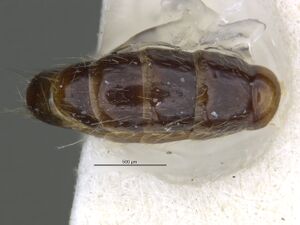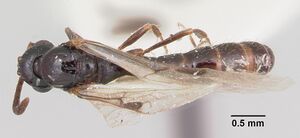Acanthostichus davisi
| Acanthostichus davisi | |
|---|---|

| |
| Scientific classification | |
| Kingdom: | Animalia |
| Phylum: | Arthropoda |
| Class: | Insecta |
| Order: | Hymenoptera |
| Family: | Formicidae |
| Subfamily: | Dorylinae |
| Genus: | Acanthostichus |
| Species: | A. davisi |
| Binomial name | |
| Acanthostichus davisi (Smith, M.R., 1942) | |
Known only from males. Specimens have been sampled from creosote bush scrub and other desert vegetation at blacklights. They are very abundant at some localities, especially in the state of Chihuahua, Mexico. (Mackay and Mackay 2002)
Identification
Keys including this Species
Distribution
Latitudinal Distribution Pattern
Latitudinal Range: 40° to 22.33333°.
| North Temperate |
North Subtropical |
Tropical | South Subtropical |
South Temperate |
- Source: AntMaps
Distribution based on Regional Taxon Lists
Nearctic Region: United States (type locality).
Neotropical Region: Mexico.
Distribution based on AntMaps
Distribution based on AntWeb specimens
Check data from AntWeb
Countries Occupied
| Number of countries occupied by this species based on AntWiki Regional Taxon Lists. In general, fewer countries occupied indicates a narrower range, while more countries indicates a more widespread species. |

|
Estimated Abundance
| Relative abundance based on number of AntMaps records per species (this species within the purple bar). Fewer records (to the left) indicates a less abundant/encountered species while more records (to the right) indicates more abundant/encountered species. |

|
Biology
Castes
Male
    
| |
| . | Owned by Museum of Comparative Zoology. |
Images from AntWeb
   
| |
| Type of Acanthostichus davisi. Male (alate). Specimen code casent0103134. Photographer April Nobile, uploaded by California Academy of Sciences. | Owned by USNM, Washington, DC, USA. |

| |
| Male (alate). Specimen code casent0010698. Photographer April Nobile, uploaded by California Academy of Sciences. | Owned by UCDC, Davis, CA, USA. |
    
| |
| Male (alate). Specimen code casent0104942. Photographer April Nobile, uploaded by California Academy of Sciences. | Owned by CAS, San Francisco, CA, USA. |
Nomenclature
The following information is derived from Barry Bolton's Online Catalogue of the Ants of the World.
- davisi. Cerapachys (Parasyscia) davisi Smith, M.R. 1942b: 64 (m.) U.S.A. (Texas).
- Type-material: holotype male, 3 paratype males.
- Type-locality: holotype U.S.A.: Texas, Jeff Davis County, Fort Davis, 5000 ft, Davis Mts, 15.xi.1927 (O.C. Poling); paratypes with same data.
- Type-depository: USNM.
- Combination in Acanthostichus: Brady, et al. 2014: 6.
- Status as species: Creighton, 1950a: 58; Smith, M.R. 1951a: 782; Brown, 1975: 22; Smith, D.R. 1979: 1333; Bolton, 1995b: 142; Mackay & Mackay, 2002: 43; Ward, 2005: 26.
- Distribution: U.S.A.
Unless otherwise noted the text for the remainder of this section is reported from the publication that includes the original description.
Description
Male
The male holotype of davisi differs from the known males of Syscia augustae as follows: Size larger (3.8 mm.); posterior border of head rounded and merging into each side without forming as definite a subangular posterior corner; all funicular segments except first distinctly longer than broad (less incrassated than in augustae); pronotum almost one-half length of mesonotum; front wing with or without a closed cubital cell; veins more prominent and more nearly enclosing radial and cubital cell (when cubital cell is not completely enclosed); sculpture different, davisi having fine rugulae between inner border of eye and antenna, and similar rugulae on epinotum, especially the sides of epinotum; sixth tergite more coarsely sculptured, subopaquc; color dark brown, almost black.
The paratypes range in length from 3.8 to 4.2 mm.
Type Material
Described from holotype and 3 paratype specimens, each bearing the label "Fort Davis, Tex., Jeff Davis County, 5000 feet, Davis Mountains, Mrs. O. C. Poling, Nov. 15, 1927." These have been assigned United States National Museum Number 56091.
References
- Brady, S.G., Fisher, B.L., Schultz, T.R., Ward, P.S. 2014. The rise of army ants and their relatives: diversification of specialized predatory doryline ants. BMC Evolutionary Biology 2014 14:93, 14 pp. (doi:10.1186/1471-2148-14-93)
- Cantone S. 2017. Winged Ants, The Male, Dichotomous key to genera of winged male ants in the World, Behavioral ecology of mating flight (self-published).
- Cantone S. 2018. Winged Ants, The queen. Dichotomous key to genera of winged female ants in the World. The Wings of Ants: morphological and systematic relationships (self-published).
- Mackay, W.P. & Mackay, E.E. 2002. The Ants of New Mexico: 400 pp. Edwin Mellen Press, Lewiston, N.Y.
- Smith, M. R. 1942b. The males of two North American cerapachyine ants. Proc. Entomol. Soc. Wash. 44: 62-64 (page 64, male described)
References based on Global Ant Biodiversity Informatics
- Cokendolpher J. C., and O. F. Francke. 1990. The ants (Hymenoptera, Formicidae) of western Texas. Part II. Subfamilies Ecitoninae, Ponerinae, Pseudomyrmecinae, Dolichoderinae, and Formicinae. Special Publications, the Museum. Texas Tech University 30:1-76.
- Dattilo W. et al. 2019. MEXICO ANTS: incidence and abundance along the Nearctic-Neotropical interface. Ecology https://doi.org/10.1002/ecy.2944
- Mackay W. P., and E. E. Mackay. 2002. The ants of New Mexico (Hymenoptera: Formicidae). Lewiston, New York: Edwin Mellen Press, 400 pp.
- O'Keefe S. T., J. L. Cook, T. Dudek, D. F. Wunneburger, M. D. Guzman, R. N. Coulson, and S. B. Vinson. 2000. The Distribution of Texas Ants. The Southwestern Entomologist 22: 1-92.
- Smith M. R. 1942. The males of two North American cerapachyine ants. Proceedings of the Entomological Society of Washington 44: 62-64.
- Vásquez-Bolaños M. 2011. Lista de especies de hormigas (Hymenoptera: Formicidae) para México. Dugesiana 18: 95-133
- Ward P. S. 2005. A synoptic review of the ants of California (Hymenoptera: Formicidae). Zootaxa 936: 1-68.
- Wheeler, G.C. and J. Wheeler. 1985. A checklist of Texas ants. Prairie Naturalist 17:49-64.

